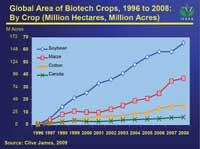Genetically Modified

The number of GM plantations continues to grow: Since they began planting in 1996, the surface planted with these plants has multiplied by 72, which is considered very beneficial in ISAAA. It is not a surprising attitude, knowing that his philosophy is to spread GMOs. These are presented on the web: "is a non-profit organization that transmits to the poor of developing countries the new technologies that appear in agriculture. The goal is to share these powerful technologies with which they will benefit and at the same time create an appropriate environment for safe use."
The data provided by ISAAA are very general and may seem unrelated to us. But no, the most transgenic issue is very close. Spain is the country with the highest number of transgenic plants in the European Union. These plants are grown mainly in the Ebro basin.
However, Ibercaja, the banking entity located in the Ebro river basin and the fourth largest in Spain have financed, among others, the report that ISAAA has just published.

In Europe only a variety of transgenic maize, Bt corn, is allowed. (Photo: Morguefile
Backward and forward
In the European Union only one species of GM, Bt corn, is allowed. Corn forms a protein to attack an insect that damages corn thanks to a gene genetically introduced into the transformation. In Spain and other countries, the proportion of GM crops has increased by 21% in Europe.
However, in all EU countries this maize does not grow. France, for example, banned planting last year. In 2007 they planted Bt corn on 22,000 hectares and in 2008 they planned to plant 100,000 hectares. However, the French Supreme Court on Genetically Modified Organisms reported in a report on the existence of unresolved issues around this maize and the possible long-term environmental impact or toxicity. In view of this, France addressed the protection clause, and not last year nor this year, has given permission for the breeding of Bt corn in French lands.
In addition to France, Austria, Hungary and Greece have addressed this clause. In the United States, at the other end, they plant more species than anywhere else: soy, corn, cotton, a type of rapeseed called canol, cuecillo, papaya, alfalfa and sugar beet.

It is easy to observe the enormous confusion that exists around GMOs. Not only among the authorities, but also among the citizens. The results of the Eurobarometer last year indicated that in Spain, at least, the figures of supporters and detractors of GMOs are very similar: 31% and 26% respectively.
More than this favorable or unfavorable position, it should be noted that in Spain, approximately 23%, has never heard of transgenic foods and that 20% do not know or do not answer. In fact, 34% of Europeans believe there is a lot of lack of information. And there are those who think without sufficient information. In fact, 58% of Europeans oppose GMOs and 21% in favor. They say that lack of information leads a lot to a pessimistic attitude.
Published in 7K.
Buletina
Bidali zure helbide elektronikoa eta jaso asteroko buletina zure sarrera-ontzian











